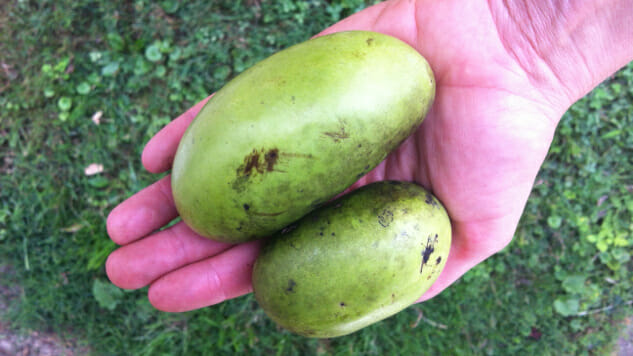5 Ways to Get Your Pawpaws on This Season
They’re native, they’re wild, and they’re unlike any fruit you’ve tasted before.
Photos by Sara Bir
Right now, at this very moment, pawpaws are ripening on millions of trees all over the eastern United States. Very few of those trees, however, grow in orchards or as ornamentals for landscaping. Pawpaws are tricky like that. They can be tamed, but only by the patient.
Interest in foraging and native fruits, plus unusual ingredients and unfamiliar flavors, has created a minor pawpaw renaissance in the food and horticulture communities. Andrew Moore’s Pawpaw: In Search of America’s Forgotten Fruit was nominated for a James Beard Foundation Award this year, and forward-thinking chefs are creating exciting ways to feature pawpaws on their menus. They taste unreal, bright and sunny with a creamy, succulent flesh.
So why did pawpaws fade from our national consciousness? This is what Moore’s book answers in detail, but the gist is that they don’t travel well, so you’ll never see one at the grocery store. In most cases, you must go to the pawpaws. Pawpaw season is nigh, and if you want to hop on the weird fruit train, now is the time, my friend.
Look for pawpaws

Finding pawpaws is half the fun! How many times in our lives do we get to embark on an Indian Jones-esque quest? The search for pawpaws, whether you are buying them or foraging for them, is where the magic starts. (Warning: It is not always for the faint of heart.)
If you live in a woodsy area east of the Mississippi, south of Canada, and north of Florida, and you are not at a high elevation (we’re talking USDA hardiness zones 5-8), then you have a decent shot at finding wild pawpaws growing in your area. I get mine from trees that grow along mountain biking trails within walking distance of my house. Pawpaw trees love to grow on shady slopes, close to creek beds, and near rivers. Be ready to scramble around in underbrush, and keep your eyes peeled for poison ivy!
I love looking for pawpaws. It gets me outside, exploring nature. Even when I come home empty-handed (some wild stands of pawpaw trees don’t produce fruit every single year), I know I at least went out on a restorative woods walk. The gamble is what makes stumbling on a pawpaw windfall truly gratifying.
But perhaps you are in an urban area and you don’t have time to traipse through the forest. Ask around at your farmers’ market—often farmers have pawpaws growing wild on their property, and the ones who love pawpaws will go rustle up a few dozen to sell at their stalls in September going into early October. When in doubt, put a post on social media asking “Where can I find pawpaws around here?” Really, it works.
Eat them in the most unadorned manner possible

-

-

-

-

-

-

-

-

-

-

-

-

-

-

-

-

-

-

-

-

-

-

-

-

-

-

-

-

-

-

-

-

-

-

-

-

-

-

-

-

 Baked pawpaw pudding tastes like pumpkin pie, only dreamier.
Baked pawpaw pudding tastes like pumpkin pie, only dreamier. This pawpaw is not just overripe—it’s rotten. Maybe it will propagate future pawpaw trees.
This pawpaw is not just overripe—it’s rotten. Maybe it will propagate future pawpaw trees.






































